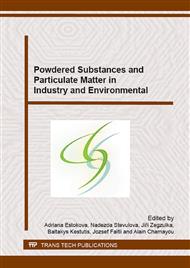p.197
p.205
p.213
p.221
p.228
p.234
p.240
p.246
p.252
The Effect of Sediment Grain Size on Heavy Metal Content in Different Depth in Water Reservoir Ruzin, Slovakia
Abstract:
Particle size is a fundamental property of any sediment, which can provide important information about its nature and provenance. The particle size distribution requires precise determination using a rapid and reliable method with a high resolution. Grain size is the essential factor influencing the heavy metal contents in sediment and is the most fundamental property of sediment particles, affecting their entrainment, transport and deposition. The aim of this paper is to present the results of the effect of particle size on heavy metal (Cu, Zn, Fe, Pb and As) distributions in sediments. Dependence between the distribution of metals in the examined profile of the sediments from Ruzin water reservoir on the different size of particles and depth is unambiguous for Cu, Zn and Fe with exception of Pb and As.
Info:
Periodical:
Pages:
240-245
Citation:
Online since:
October 2015
Authors:
Keywords:
Price:
Сopyright:
© 2016 Trans Tech Publications Ltd. All Rights Reserved
Share:
Citation:


